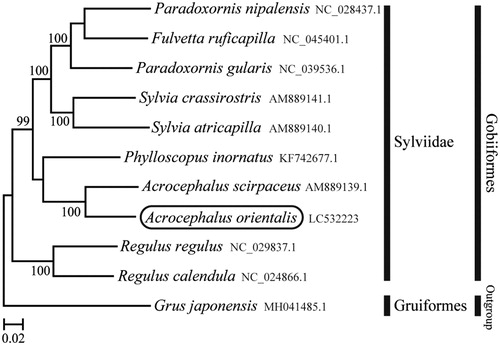Abstract
The complete mitochondrial genome of the Oriental reed warbler, Acrocephalus orientalis, which belongs to the family Sylviidae was determined. The complete mitochondrial genome has a length of 16,971 bp and consists of 13 protein-coding genes, 22 tRNA genes, 2 rRNA genes, and a control region. A. orientalis has a mitochondrial gene arrangement that is typical of vertebrates. Phylogenetic analysis using mitochondrial genomes of 11 related species revealed that A. orientalis is clustered with Acrocephalus scirpaceus and rooted with the other Sylviidae species. This mitochondrial genome provides an important resource for addressing taxonomic issues and studying molecular evolution.
The Oriental reed warbler, Acrocephalus orientalis (Passeriformes: Sylviidae), is a relatively large-bodied (18–20 cm in length) migratory bird native to East and Southeast Asia. This species occupies a unique ecological niche resulting from their long-range migration between breeding (China, Korea, and Japan) and winter habitats (Southeast Asia to Philippines and Indonesia). These traits also make them particularly vulnerable to habitat destruction and the effects of climate change. In this study, we determined the complete mitochondrial DNA sequence of A. orientalis and compared the sequence with those of other species of Sylviidae to analyze the phylogenetic relationship between them.
The A. orientalis specimen was collected from Heuksan Island, Republic of Korea (34.41N, 125.25E). Total genomic DNA was extracted from the specimen tissue, which has been deposited at the National Institute of Biological Resources (NIBR) (Voucher No. NIBRGR0000134238). The mitogenome was sequenced using Illumina Hiseq 4000 sequencing platform (Illumina, San Diego, CA) and assembled with SOAPdenovo at Macrogen Inc. (Seoul, Korea). The complete mitochondrial genome was annotated using MacClade version 4.08 (http://macclade.org/) (Maddison and Maddison Citation2005) and tRNAscan-SE version 2.0 (http://trna.ucsc.edu/tRNAscan-SE/) (Lowe and Chan Citation2016). All sampling activities were conducted in accordance with the Guidelines of Animal Ethics published by the NIBR.
The complete mitochondrial genome of A. orientalis (GenBank accession no. LC532223) is 16,971 bp in length and includes 13 protein-coding genes, 22 tRNA genes, 2 rRNA genes, and a control region. The overall base composition is 29.89% A, 31.97% C, 15.09% G, and 23.05% T. Similar to the mitogenomes of other vertebrates, the AT content is higher than the GC content (Saccone et al. Citation1999). The 12S rRNA (1181 bp) and 16S rRNA genes (1606 bp) are located between tRNAPhe and tRNAVal and between tRNAVal and tRNALeu(UUR), respectively. The start codon of the 13 protein-coding genes begins with the sequence ATG. The stop codon of the protein-coding genes is TAA (ND2, COII, ATP8, ATP6, ND3, ND4L, Cytb, and ND6), TA (ND1), AGG (COI), T (COIII and ND4), and AGA (ND5). A control region (106 bp) is located between tRNAGlu and tRNAPhe.
The phylogenetic trees were constructed by the maximum-likelihood method with 1000 replicates using MEGA version 7.0 software (MEGA, Philadelphia, PA) (Kumar et al. Citation2016). We compared the phylogenetic trees of the newly sequenced genome and 10 other complete Sylviidae species mitochondrial genome sequences acquired from the National Center for Biotechnology Information. We confirmed that A. orientalis is clustered with Acrocephalus scirpaceus (Singh et al. Citation2008) and rooted with the other Sylviidae species (Cai et al. Citation2019; Sun et al. Citation2020) (). This mitochondrial genome provides an important resource for addressing taxonomic issues and studying molecular evolution.
Disclosure statement
No potential conflict of interest was reported by the author(s)
Data availability
The data that support the findings of this study are openly available in the DNA Data Bank of Japan (accession no. LC532223) at https://www.ddbj.nig.ac.jp.
Additional information
Funding
References
- Cai T, Cibois A, Alström P, Moyle RG, Kennedy JD, Shao S, Zhang R, Irestedt M, Ericson GP, Gelang M, et al. 2019. Near-complete phylogeny and taxonomic revision of the world’s babblers (Aves: Passeriformes). Mol Phylogenet E. 130:346–356.
- Kumar S, Stecher G, Tamura K. 2016. MEGA7: molecular evolutionary genetics analysis version 7.0 for bigger datasets. Mol Biol Evol. 33(7):1870–1874.
- Lowe TM, Chan PP. 2016. tRNAscan-SE On-line: integrating search and context for analysis of transfer RNA genes. Nucleic Acids Res. 44(W1):W54–W57.
- Maddison DR, Maddison WP. 2005. MacClade 4: analysis of phylogeny and character evolution. ver. 4.08. Sunderland (MA): Sinauer Associates.
- Saccone C, De Giorgi C, Gissi C, Pesole G, Reyes A. 1999. Evolutionary genomics in Metazoa: the mitochondrial DNA as a model system. Gene. 238(1):195–209.
- Singh TR, Shneor O, Huchon D. 2008. Bird mitochondrial gene order: insight from 3 warbler mitochondrial genomes. Mol Biol Evol. 25(3):475–477.
- Sun CH, Liu HY, Lu CH. 2020. Five new mitogenomes of Phylloscopus (Passeriformes, Phylloscopidae): sequence, structure, and phylogenetic analyses. Int J Biol Macromol. 146:638–647.

